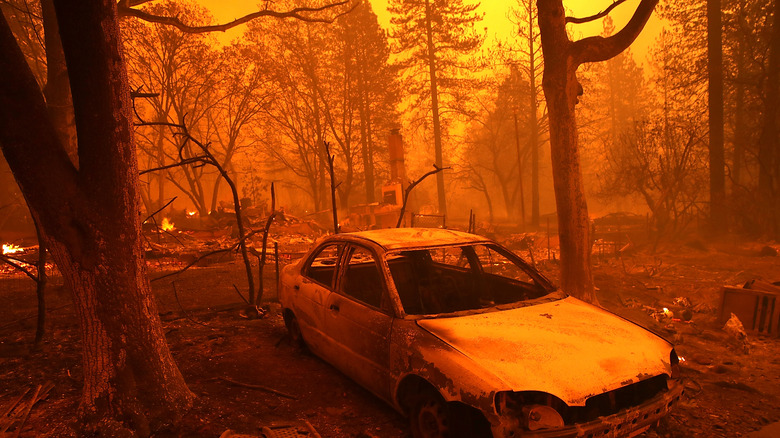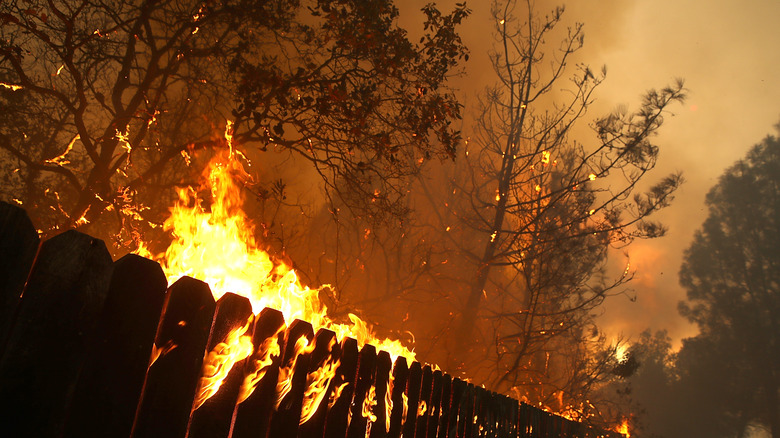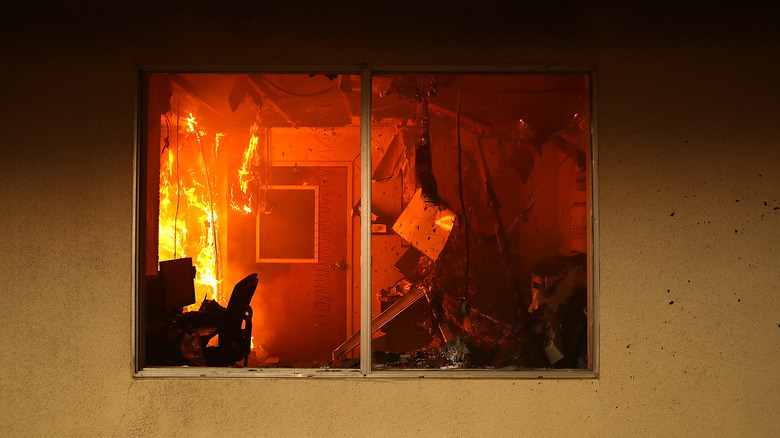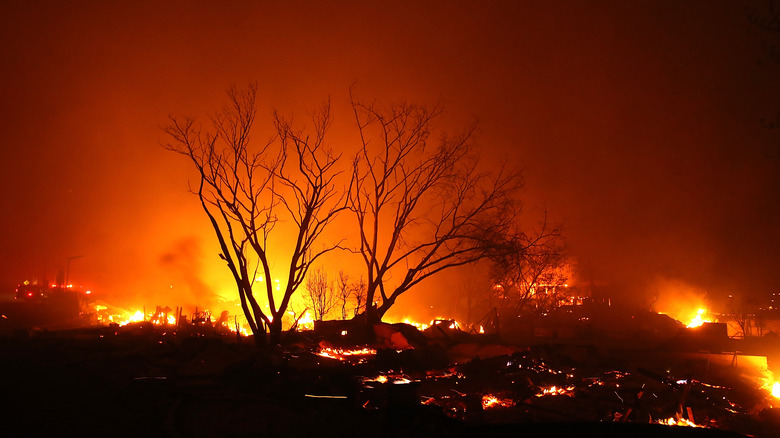The Story Of The Deadliest Wildfire In California History
California is no stranger to wildfires and some trees like giant sequoias have even adapted to thrive in settings prone to fire, reports The Guardian. But tragically, little survived in the wake of the 2018 Camp Fire wildfire, which burned so quickly that it covered "a football field every second," per CNN. Several towns were absolutely devastated by the fire and as thousands scrambled to evacuate, scores of people lost their lives to the encroaching flames.
While intense winds and low humidity fueled the fire, the tragedy was ultimately revealed to be man-made. Meanwhile, the company responsible ended up facing criminal charges for its role in the fire, which was the first time that any major utility company pleaded guilty to 84 counts of involuntary manslaughter and one count of unlawfully starting a fire, per NPR.
The investigation into the wildfire would find that many of the decisions that led to the 2018 Camp Fire wildfire were made up to 40 years before the wildfire. But some of the issues were almost 100 years old. In the end, considering the reckless behavior of the company, the failure that resulted was clearly a "not if but when" scenario.
The Camp Fire wildfire begins
Around 6:15 in the morning on November 8, 2018, the Pacific Gas & Electric (PG&E) Grid Control Center noted an "interruption" on one of their Caribou-Palermo near Pulga, California. Later, Cal Fire investigators would determine that the interruption was caused by a failed C-hook, which led to molten aluminum and steel falling to the dry brush on the ground and starting a fire. According to The Camp Fire Public Report, a second fire started 2.6 miles west of the first fire and ignited when a Ponderosa pine tree fell onto and broke a distribution line. The second fire was soon engulfed by the first blaze, but ultimately had "little, or no, effect on the Camp Fire."
According to the Bulletin of the American Meteorological Society, the strong northeasterly winds allowed the fire to easily expand and within two hours, it reached the northeast border of the town of Paradise. In the first 24 hours alone, the fire raged through 70,000 acres of land. In the end, it took 17 days to contain the wildfire. By that point, the wildfire had burned through almost 154,000 acres.
At the time, imprisoned people who act as firefighters "outnumbered California's seasonal firefighters more than two-to-one," according to Frontline. And while typically their work entailed cutting down fences and clearing brush, during the 2018 Camp Fire wildfire, they instead had to contend with "burning buildings and a chaotic evacuation."
A deadly and destructive tragedy
The 2018 Camp Fire wildfire in California remains, as of the time of this writing, the deadliest and most destructive wildfire in the history of California. 84 people died as a result of the wildfire and there were three people, two civilians, and one firefighter, who suffered severe injuries, according to The Camp Fire Public Report. One person, Sara Martinez-Fabila, was never found after the Camp Fire wildfire and is still missing, per Record Spotlight.
According to CNBC, over 18,800 structures were destroyed in the fire as well across several towns. And towns like Paradise, which had a population of 27,000, were almost entirely burnt to the ground, as were the neighboring towns of Concow and Magalia.
It also ended up being an incredibly costly disaster. Time Magazine reports that the wildfire caused $16.5 billion in overall losses. And for many of the survivors, there was little relief even after the fires had subsided. Despite some aid being made available from the state and federal government and nonprofits, they would require paperwork that existed only as ash in a burnt-down town. "Others found themselves missing deadlines for aid that they never even knew existed until it was too late," Vox writes. And for those without renter's insurance, there was "literally nowhere to go."
PG&E pleads guilty
In 2019, an investigation led by the Butte County District Attorney found that the 2018 Camp Fire wildfire was caused by PG&E's outdated power lines, faulty maintenance, and failure to follow state regulations, according to NPR. The Camp Fire Public Report found that the C-hook that broke was "at least 97 years old." And because PG&E had no records of said hook, they didn't even know what type of metal the C hook was made out of. "The fact that PG&E was using a 97-100-year-old conductor for which they knew almost nothing is evidence of absolute indifference on the part of PG&E," the report stated.
After facing criminal charges of 84 counts of involuntary manslaughter and one felony count of unlawfully starting a fire, PG&E pled guilty to every single charge on June 16, 2020, in addition to waiving the company's right to appeal. As part of the plea deal, PG&E was ordered to pay a fine of $3.5 million as well as a $25.5 billion settlement to compensate "victims, their families, and Butte County agencies," per NPR.
This also wasn't the first fire caused by PG&E. Business Insider reports that between 2013 and 2019, PG&E power lines caused over 1,500 wildfires in California. In 2020, the California Public Utilities Commission also imposed a $1.93 billion penalty on PG&E for the wildfires it caused between 2017 and 2018, per Utility Drive.



